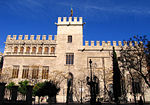Valencia Cathedral

Valencia Cathedral, at greater length the Metropolitan Cathedral–Basilica of the Assumption of Our Lady of Valencia (Spanish: Iglesia Catedral-Basílica Metropolitana de la Asunción de Nuestra Señora de Valencia, Valencian: Església Catedral-Basílica Metropolitana de l'Assumpció de la Mare de Déu de València), also known as St Mary's Cathedral, is a Roman Catholic church in Valencia, Spain. The cathedral was consecrated in 1238 by the first bishop of Valencia after the Reconquista, Pere d'Albalat, Archbishop of Tarragona, and was dedicated to Saint Mary by order of James I the Conqueror. It was built over the site of the former Visigothic cathedral, which under the Moors had been turned into a mosque. Valencian Gothic is the predominant architectural style of the cathedral, although it also contains Romanesque, French Gothic, Renaissance, Baroque and Neoclassical elements. The cathedral contains numerous 15th-century paintings, some by local artists (such as Jacomart), others by artists from Rome engaged by the Valencian Pope Alexander VI who, when still a cardinal, made the request to elevate the Valencian See to the rank of metropolitan see, a category granted by Pope Innocent VIII in 1492. A purported Holy Chalice, believed by many to be the true Holy Grail, is kept in one of the cathedral's chapels.
Excerpt from the Wikipedia article Valencia Cathedral (License: CC BY-SA 3.0, Authors, Images).Valencia Cathedral
Plaça de la Reina, Valencia Ciutat Vella
Geographical coordinates (GPS) Address External links Nearby Places Show on map
Geographical coordinates (GPS)
| Latitude | Longitude |
|---|---|
| N 39.475833333333 ° | E -0.375 ° |
Address
Catedral de Valencia (Catedral de Santa María)
Plaça de la Reina
46003 Valencia, Ciutat Vella
Valencian Community, Spain
Open on Google Maps










